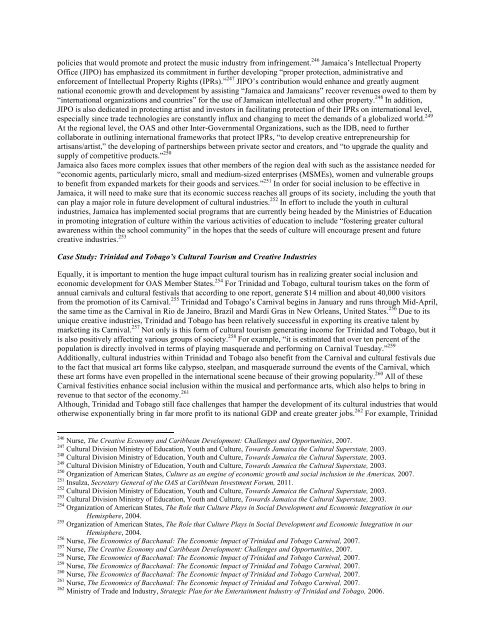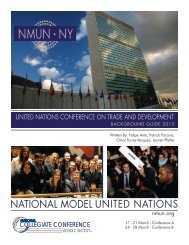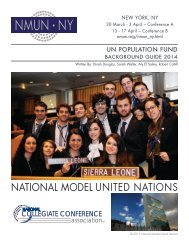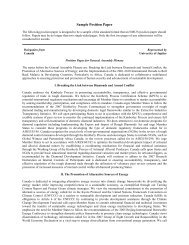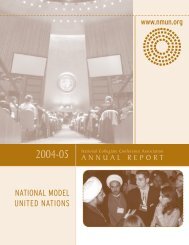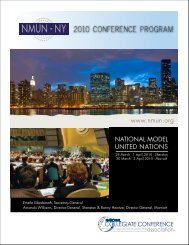Organization of American States - National Model United Nations
Organization of American States - National Model United Nations
Organization of American States - National Model United Nations
Create successful ePaper yourself
Turn your PDF publications into a flip-book with our unique Google optimized e-Paper software.
policies that would promote and protect the music industry from infringement. 246 Jamaica’s Intellectual Property<br />
Office (JIPO) has emphasized its commitment in further developing “proper protection, administrative and<br />
enforcement <strong>of</strong> Intellectual Property Rights (IPRs).” 247 JIPO’s contribution would enhance and greatly augment<br />
national economic growth and development by assisting “Jamaica and Jamaicans” recover revenues owed to them by<br />
“international organizations and countries” for the use <strong>of</strong> Jamaican intellectual and other property. 248 In addition,<br />
JIPO is also dedicated in protecting artist and investors in facilitating protection <strong>of</strong> their IPRs on international level,<br />
especially since trade technologies are constantly influx and changing to meet the demands <strong>of</strong> a globalized world. 249<br />
At the regional level, the OAS and other Inter-Governmental <strong>Organization</strong>s, such as the IDB, need to further<br />
collaborate in outlining international frameworks that protect IPRs, “to develop creative entrepreneurship for<br />
artisans/artist,” the developing <strong>of</strong> partnerships between private sector and creators, and “to upgrade the quality and<br />
supply <strong>of</strong> competitive products.” 250<br />
Jamaica also faces more complex issues that other members <strong>of</strong> the region deal with such as the assistance needed for<br />
“economic agents, particularly micro, small and medium-sized enterprises (MSMEs), women and vulnerable groups<br />
to benefit from expanded markets for their goods and services.” 251 In order for social inclusion to be effective in<br />
Jamaica, it will need to make sure that its economic success reaches all groups <strong>of</strong> its society, including the youth that<br />
can play a major role in future development <strong>of</strong> cultural industries. 252 In effort to include the youth in cultural<br />
industries, Jamaica has implemented social programs that are currently being headed by the Ministries <strong>of</strong> Education<br />
in promoting integration <strong>of</strong> culture within the various activities <strong>of</strong> education to include “fostering greater cultural<br />
awareness within the school community” in the hopes that the seeds <strong>of</strong> culture will encourage present and future<br />
creative industries. 253<br />
Case Study: Trinidad and Tobago’s Cultural Tourism and Creative Industries<br />
Equally, it is important to mention the huge impact cultural tourism has in realizing greater social inclusion and<br />
economic development for OAS Member <strong>States</strong>. 254 For Trinidad and Tobago, cultural tourism takes on the form <strong>of</strong><br />
annual carnivals and cultural festivals that according to one report, generate $14 million and about 40,000 visitors<br />
from the promotion <strong>of</strong> its Carnival. 255 Trinidad and Tobago’s Carnival begins in January and runs through Mid-April,<br />
the same time as the Carnival in Rio de Janeiro, Brazil and Mardi Gras in New Orleans, <strong>United</strong> <strong>States</strong>. 256 Due to its<br />
unique creative industries, Trinidad and Tobago has been relatively successful in exporting its creative talent by<br />
marketing its Carnival. 257 Not only is this form <strong>of</strong> cultural tourism generating income for Trinidad and Tobago, but it<br />
is also positively affecting various groups <strong>of</strong> society. 258 For example, “it is estimated that over ten percent <strong>of</strong> the<br />
population is directly involved in terms <strong>of</strong> playing masquerade and performing on Carnival Tuesday.” 259<br />
Additionally, cultural industries within Trinidad and Tobago also benefit from the Carnival and cultural festivals due<br />
to the fact that musical art forms like calypso, steelpan, and masquerade surround the events <strong>of</strong> the Carnival, which<br />
these art forms have even propelled in the international scene because <strong>of</strong> their growing popularity. 260 All <strong>of</strong> these<br />
Carnival festivities enhance social inclusion within the musical and performance arts, which also helps to bring in<br />
revenue to that sector <strong>of</strong> the economy. 261<br />
Although, Trinidad and Tobago still face challenges that hamper the development <strong>of</strong> its cultural industries that would<br />
otherwise exponentially bring in far more pr<strong>of</strong>it to its national GDP and create greater jobs. 262 For example, Trinidad<br />
246 Nurse, The Creative Economy and Caribbean Development: Challenges and Opportunities, 2007.<br />
247 Cultural Division Ministry <strong>of</strong> Education, Youth and Culture, Towards Jamaica the Cultural Superstate, 2003.<br />
248 Cultural Division Ministry <strong>of</strong> Education, Youth and Culture, Towards Jamaica the Cultural Superstate, 2003.<br />
249 Cultural Division Ministry <strong>of</strong> Education, Youth and Culture, Towards Jamaica the Cultural Superstate, 2003.<br />
250 <strong>Organization</strong> <strong>of</strong> <strong>American</strong> <strong>States</strong>, Culture as an engine <strong>of</strong> economic growth and social inclusion in the Americas, 2007.<br />
251 Insulza, Secretary General <strong>of</strong> the OAS at Caribbean Investment Forum, 2011.<br />
252 Cultural Division Ministry <strong>of</strong> Education, Youth and Culture, Towards Jamaica the Cultural Superstate, 2003.<br />
253 Cultural Division Ministry <strong>of</strong> Education, Youth and Culture, Towards Jamaica the Cultural Superstate, 2003.<br />
254 <strong>Organization</strong> <strong>of</strong> <strong>American</strong> <strong>States</strong>, The Role that Culture Plays in Social Development and Economic Integration in our<br />
Hemisphere, 2004.<br />
255 <strong>Organization</strong> <strong>of</strong> <strong>American</strong> <strong>States</strong>, The Role that Culture Plays in Social Development and Economic Integration in our<br />
Hemisphere, 2004.<br />
256 Nurse, The Economics <strong>of</strong> Bacchanal: The Economic Impact <strong>of</strong> Trinidad and Tobago Carnival, 2007.<br />
257 Nurse, The Creative Economy and Caribbean Development: Challenges and Opportunities, 2007.<br />
258 Nurse, The Economics <strong>of</strong> Bacchanal: The Economic Impact <strong>of</strong> Trinidad and Tobago Carnival, 2007.<br />
259 Nurse, The Economics <strong>of</strong> Bacchanal: The Economic Impact <strong>of</strong> Trinidad and Tobago Carnival, 2007.<br />
260 Nurse, The Economics <strong>of</strong> Bacchanal: The Economic Impact <strong>of</strong> Trinidad and Tobago Carnival, 2007.<br />
261 Nurse, The Economics <strong>of</strong> Bacchanal: The Economic Impact <strong>of</strong> Trinidad and Tobago Carnival, 2007.<br />
262 Ministry <strong>of</strong> Trade and Industry, Strategic Plan for the Entertainment Industry <strong>of</strong> Trinidad and Tobago, 2006.


